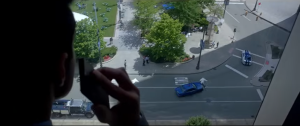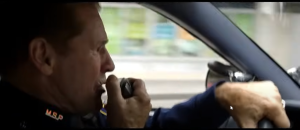 Medium Long Shot: The framing captures the cars from dynamic angles, often low to the ground, emphasizing speed and intensity. The protagonist’s Mustang is framed in a way that shows it in the foreground, dominating the scene. This indicates its importance and sets up a narrative focus on the car chase.
Medium Long Shot: The framing captures the cars from dynamic angles, often low to the ground, emphasizing speed and intensity. The protagonist’s Mustang is framed in a way that shows it in the foreground, dominating the scene. This indicates its importance and sets up a narrative focus on the car chase.
 Long Shot: The overhead view changes the dynamic of the chase, offering a strategic overview. This shift contrasts with the close, ground-level shots and gives the audience a broader sense of the environment and the chase’s progression through the city streets. The top-down view allows the audience to see multiple elements at once—both the blue car involved in the chase and other aspects of the environment, such as the city layout and pedestrian activity. This comprehensive view creates a sense of scale and context, situating the chase within a larger urban setting.
Long Shot: The overhead view changes the dynamic of the chase, offering a strategic overview. This shift contrasts with the close, ground-level shots and gives the audience a broader sense of the environment and the chase’s progression through the city streets. The top-down view allows the audience to see multiple elements at once—both the blue car involved in the chase and other aspects of the environment, such as the city layout and pedestrian activity. This comprehensive view creates a sense of scale and context, situating the chase within a larger urban setting.
 Medium close up/close up: The tight shot, focusing on the cop’s face, hand on the steering wheel, and the radio, creates a sense of immediacy and tension. It suggests that the situation is critical, and every moment counts. The slight blur in the background indicates motion, keeping the viewer aware that this is happening during the high-speed chase.
Medium close up/close up: The tight shot, focusing on the cop’s face, hand on the steering wheel, and the radio, creates a sense of immediacy and tension. It suggests that the situation is critical, and every moment counts. The slight blur in the background indicates motion, keeping the viewer aware that this is happening during the high-speed chase.
 Medium long shot: The rear shot of the Mustang drifting around the corner, as if viewed from the perspective of the cop car, places the audience directly in the chase. This perspective mimics what the pursuing cop would see, enhancing the viewer’s connection to the intensity of the pursuit.
Medium long shot: The rear shot of the Mustang drifting around the corner, as if viewed from the perspective of the cop car, places the audience directly in the chase. This perspective mimics what the pursuing cop would see, enhancing the viewer’s connection to the intensity of the pursuit.
The combination of close-ups, top-down views, and dynamic chase shots builds and sustains tension throughout the sequence. By alternating between the perspectives of the protagonist, the pursuers, and the observer, the film keeps the audience on edge, fully engaged in the unfolding action.